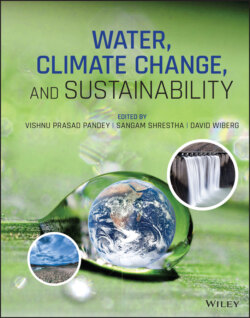Читать книгу Water, Climate Change, and Sustainability - Группа авторов - Страница 41
3.2.3. Water Use in Biomass Conversion to Biofuels
ОглавлениеBiomass processing uses water for buffers and media preparation, pretreatment, cleaning, heating, waste heat recovery, cooling, as well as the reactant and fluidizing agent. Processing phase in bioethanol industry uses water mainly for cooling purpose (Phillips et al., 2007). While water use in processing phase may be recycled, there are water losses primarily due to evaporation from cooling towers and utility systems (Phillips et al., 2007). In the US, 1 L of ethanol production from corn grain requires ~3 L of water (University of Illinois Extension, 2009). Table 3.2 summarizes the water footprint of biofuels from different feedstocks. Ethanol production from sugarcane in Brazil requires large amount of water for washing, condensing the vapor, and cooling the fermentation broth (Stone et al., 2013).
Most of the biorefineries are located in the same regions of biomass production, which reduces the transportation and logistics costs; however, the large quantities of water demand by the biorefineries exert pressure on the limited water resources. For example, corn ethanol biorefineries in the US are mainly located in the Midwest, where there is already a pressing need for water in biomass production, food production, and processing systems (Phillips et al., 2007). Water use in the corn ethanol industry in the US is taken from the local aquifer (Phillips et al., 2007). Due to the concerns over water use in bioprocessing, there is an interest in using improved systems to avoid evaporation and leaks (Stone et al., 2013). One solution is use of “zero discharge” system that recycles water in the ethanol industry and avoids the discharge (Phillips et al., 2007). Cooling systems is a main water consumer in ethanol biorefineries (Phillips et al., 2007). Air cooling can be implemented to replace the cooling water. Biodiesel production industry also requires large amount of water, ranging from 119 m3/GJ for biodiesel production from canola, to 444 m3/GJ for biodiesel production from palm (Table 3.2). Different conversion phases of corn to ethanol and soybean to biodiesel are presented in Figure 3.2.
Table 3.2 Water footprint of biofuels from different feedstocks.
| Fuel | Feedstock | Water footprint (m3/GJ energy)* | Reference |
|---|---|---|---|
| Bioethanol | Sugarcane | 20–63 | Postel, 1998 |
| Sugar beet | 96 | Yang et al., 2009 | |
| Corn | 87–90 | Postel, 1998 | |
| Sweet sorghum | 31 | Berndes, 2002 | |
| Grain sorghum | 319 | Critchley et al., 1991 | |
| Cassava | 113 | Yang et al., 2009 | |
| Sweet potato | 78 | Yang et al., 2009 | |
| Switchgrass | 67 | Robins et al., 2009 | |
| Biodiesel | Rapeseed | 165 | Yang et al., 2009 |
| Palm | 444 | Yang et al., 2009 | |
| Soybean | 237 | Critchley et al., 1991 | |
| Canola | 119 | Bauder, 2019; |
* Data shows the water footprint for production of biomass and conversion to fuels.
Figure 3.2 Water use in ethanol production from corn, and biodiesel production from soybean.
